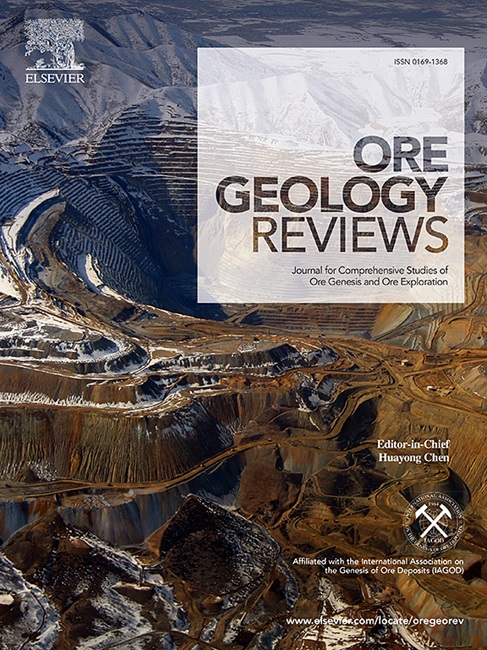Solution-collapse breccia pipe uranium deposits of the southern Colorado Plateau, northwestern Arizona, USA
IF 3.2
2区 地球科学
Q1 GEOLOGY
引用次数: 0
Abstract
Some of the highest-grade uranium deposits in the United States occur in breccia pipes that formed by solution and collapse of sedimentary strata, which occur in the southern portion of the Colorado Plateau in northwestern Arizona. The host breccia pipes are up to 1200 m in vertical extent, average about 90 m in diameter, and can cross-cut strata from their base in the Mississippian Redwall Limestone to as stratigraphically high on some plateaus as the Triassic Chinle Formation. These uranium-base metal deposits are up to 600 m thick and formed within the breccia pipes where they transect the Permian Coconino Sandstone, Hermit Formation, and the Esplanade Sandstone. Of the hundreds of breccia pipes identified across this region, only a small percentage are known to contain mineralization. The main uranium ore mineral is uraninite that is intergrown with at least 20 base-metal sulfide minerals, which contribute Fe, Cu, Co, As, Pb, Zn, Ni, and Ag to the deposits.
This study considered regional stratigraphy, sulfur isotope systematics, mineralogy, in situ dating, and compilation and analysis of previous work on the deposits. A comprehensive deposit model has not been published for these deposits. This analysis identified new additions to update the deposit model for these unusual, possibly unique deposits. Proposed modifications to the model include: (1) the source, mechanisms, timing of the base-metal sulfide mineral assemblages, and (2) the source, mechanism, and timing of the uranium mineralization. Sulfide and uranium deposition are shown to be separate mineralization events. The study proposes the possible role of gypsum as a source of sulfur for the sulfide minerals in the deposits. Groundwaters carrying uranium encountered the preexisting sulfides in breccia pipes, reducing the uranyl ions, and precipitating U oxide (as uraninite). Analysis of the regional stratigraphy recognized that numerous beds of gypsum are in the strata that lie only tens of meters above the breccia pipe deposits. In the breccia pipe region, if these stratigraphic units (Toroweap and Kaibab Formations) do not contain gypsum layers then the underlying pipes are not mineralized; where these Permian gypsum layers do occur, breccia pipes can host mineralization. This new understanding should be useful in identifying the prospective region for mineralized pipes.

美国亚利桑那州西北部科罗拉多高原南部的溶蚀-塌陷角砾岩管铀矿床
美国一些品位最高的铀矿床位于亚利桑那州西北部科罗拉多高原南部沉积地层溶蚀和崩塌形成的角砾岩管中。主角砾岩管的垂直范围可达 1200 米,平均直径约 90 米,可穿过从密西西比红墙石灰岩基底到某些高原三叠纪钦勒地层的地层。这些铀基金属矿床厚达 600 米,形成于横穿二叠纪可可尼诺砂岩、赫米特地层和埃斯普拉纳德砂岩的角砾岩管内。在该地区发现的数百个角砾岩管中,只有一小部分含有矿化物。主要的铀矿石矿物是铀矿石,它与至少 20 种贱金属硫化物矿物互生,这些矿物为矿床提供了铁、铜、钴、砷、铅、锌、镍和银。这些矿床的综合矿床模型尚未公布。这次分析为这些不寻常的、可能是独一无二的矿床确定了新的补充内容,以更新矿床模型。建议对模型进行的修改包括(1) 贱金属硫化物矿物组合的来源、机制和时间,以及 (2) 铀矿化的来源、机制和时间。硫化物和铀沉积被证明是不同的成矿事件。研究提出石膏可能是矿床中硫化物矿物的硫源。携带铀的地下水遇到角砾岩管道中的原有硫化物,使铀离子还原,并沉淀出氧化铀(作为铀矿石)。对区域地层的分析表明,在角砾岩管矿床上方仅数十米的地层中存在大量石膏层。在砾岩管道区域,如果这些地层单元(托罗韦普地层和凯巴布地层)不包含石膏层,那么下面的管道就不会有矿化;如果这些二叠纪石膏层确实存在,那么砾岩管道就会有矿化。这一新认识将有助于确定矿化管道的远景区域。
本文章由计算机程序翻译,如有差异,请以英文原文为准。
求助全文
约1分钟内获得全文
求助全文
来源期刊

Ore Geology Reviews
地学-地质学
CiteScore
6.50
自引率
27.30%
发文量
546
审稿时长
22.9 weeks
期刊介绍:
Ore Geology Reviews aims to familiarize all earth scientists with recent advances in a number of interconnected disciplines related to the study of, and search for, ore deposits. The reviews range from brief to longer contributions, but the journal preferentially publishes manuscripts that fill the niche between the commonly shorter journal articles and the comprehensive book coverages, and thus has a special appeal to many authors and readers.
 求助内容:
求助内容: 应助结果提醒方式:
应助结果提醒方式:


